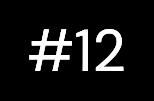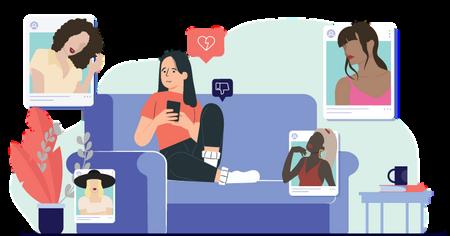






















5.3 billion people worldwide use the internet, with 4.95 billion also using social media sites. (Shewale, 2024)

The use of the internet has expanded dramatically during the last decade. Whereas a smart phone or computer is no longer considered a luxury or commodity but rather a need. The use of social platforms has increased tremendously, from MySpace to Snapchat, the majority of the world is quite familiar with social media.
• The average daily Internet usage duration across all devices is 6 hours and 35 minutes. That is approximately 27% of your day spent online.
• In Canada, about 93.8% of internet users are also social media users.
(We Are Social, 2023)



The triple revolution refers to the technological transition that has resulted in a more interconnected society. It is the reason behind the shift to networked individualism. It provides the framework and resources for us to be capable of having things like Google and texting platforms!
The Triple Revolution resulted from the widespread deployment of broadband Internet (wireless, highspeed data transmission) Mobile connectivity (smart phones, smart watches, and social media platforms (such as Facebook and Instagram)
(Rainie & Wellman, 2019)Networked individualism describes the modern social structure that has shifted from traditional forms due to the increasing integration of technology into daily life This provides individuals with greater autonomy and independence as they access socialization, news, education, and convenience through digital means With reduced reliance on traditional media like newspapers and landlines, people now have more control over the content they consume and the relationships they form.
(Rainie & Wellman, 2019)
Ittakes a village to raise a child?sNo!Justa ubreddit
Digital socialization does not always replicate faceto-face interactions accurately A phone call or text can differ significantly from the real thing This allows individuals to be deceptive online, such as through Photoshop or catfishing, or to feel invincible behind a screen (cyberbullying and keyboard warriors) Users may experience loneliness, fomo, and self-comparison as a result of this relationship mismatch

Self-esteem encompasses more than just an emotional response to oneself, involving both the degree of self-liking and the cognitive evaluation of one's worth, including skills and intelligence. It represents an individual's comprehensive perception of themselves, similar to self-confidence, as it is contingent on our perception of self-worth. Various factors, such as personal beliefs, relationships, and life encounters, contribute to shaping self-esteem. Culture, ethnicity, gender, and social positionality can all have a big impact on how people perceive themselves. External influences, such as feedback from others and media consumption, frequently have a direct impact on people's self-esteem (Liu et al., 2016).

Having a healthy self esteem includes security in oneself Having trust in your skills and abilities Able to recognize strengths and weaknesses, but not to penalize yourself for them. Individuals with high self esteem hold realistic expectations for themselves and others. It is a balance between confidence and humility. Balance between recognition of flaws, and blatant criticism. Individuals with high self esteem are resilient


Low self-esteem leads to self-doubt. Taking others opinions too personally and relying on external validations for reassurance Having a low self esteem leads an individual to feel below or inferior to others. Focusing on the negative more than the positive. Afraid of making mistakes, and nervous of feedback

Well-Being: A healthy self-esteem is closely linked to overall well-being. Well-being forms the foundation for emotional stability and self-regulation, confidence and overall content with one's identity and person. Healthy well-being facilitates effective stress management, empowering individuals to rebound from setbacks and persevere through failures.
Resilience: People with higher levels of self-esteem are more proficient at overcoming hurdles and disappointments in life Higher self-esteem typically encourages people to adopt constructive coping strategies when faced with hardship, according to the American Psychological Association
Relationships: Individuals who are secure and happy with who they are tend to maintain healthy relationships better. High self-esteem is correlated with high emotional intelligence, communication, and interpersonal respect. Having the capacity to put things in perspective rather than take things personally helps keep relationships healthy.
Prosocial Behaviours: Prosocial behaviour is defined as behaviour carried out for the benefit of another individual or of society at large Empathy and understanding toward others, as well as positive acts towards others, are associated with high self-esteem
Mental Health: Efficient coping mechanisms and a general sense of well-being have the potential to mitigate symptoms linked to a range of mental illnesses, including anxiety and depression Because lower levels of self-esteem are associated with a higher vulnerability to these symptoms, high selfesteem is generally seen as a protective factor against such disorders.
(Vanbuskirk, 2021)
Numerous studies have found a strong correlation between excessive use of social media and negative mental health outcomes, as well as lower self-esteem. This link is not only visible in quantitative studies, but also in qualitative interviews, demonstrating the deep influence that social media may have on the minds of impressionable youth.
The study involved 467 adolescents from Scotland, with a reported social media usage rate of 97%. Among them, approximately 35% were identified as experiencing poor sleep, while 47% reported feelings of anxiety and 21% reported symptoms of depression. In the t d th lt fi d high l ti b t i di id l

Another study discovered a considerable link between daily social activity and self-esteem levels. Spending more than three hours each day on social media and participating in more upward social comparisons were connected to lower self-esteem. The link between increasing social media use and poorer self-esteem was clear (Tibber et al., 2020).




“Sometimes I am aware of how bad it makes me feel but I keep using it just because I want to continue my self-loathing.” (Rideout & Fox, 2018)
“Social media… makes things worse simply because I have told myself time and time again that I wouldn't spend so much time mindlessly scrolling through other people's


“Usually friends post happy things - getting together with others, accomplishments, bragging. I don’t always want to see it when I’m feeling down about myself so I stay off social media.”(Rideout
& Fox, 2018)
“Whenever I'm having an anxiety attack I have to put down my phone and calm down.” (Rideout & Fox, 2018)
“When I feel upset I just stay off social media all together.”
(Rideout & Fox, 2018)
https://assets.hopelab.org/wpcontent/uploads/2020/08/a-national-survey-byhopelab-and-well-being-trust-2018.pdf


‘Who Am I?’, the answer to this question varies depending on who you’re with, where you are, and situational context. Everybody has multiple versions of themselves that they portray to align with social norms. For example, you may present a different identity or version at church, versus school, versus a bar/club setting. The self, or self-concept is who we believe to be, and who we show others we are. Self perception is the building block for our motivations, goals, behaviours and emotional processing. The self is consists of three divisions: Actual Self, Ideal Self and Ought Self.
The actual self is the person we believe ourselves to be, who we think our true selves are, the identity that is the truest version of you. It can be comprised of factual information about ourselves, (gender, occupation, achievements etc). As well as the way you perceive yourself, your demeanour, skills, personality.
The ideal is the person we wish to be, the traits we wish to possess, our goals, aspirations and the behaviours we want to practice.

The ought self, is who we believe we should be. The timeline we should follow, the career path we should pursue, the relationships we think we should, and traits we think we should possess

Self-discrepancy theory suggests that when there is a large discrepancy or gap between our actual self, and our ideal self or ought self, it generates negative feelings, usually of discomfort and failure. The bigger the inconsistency, the higher the discontent and general life dissatisfaction (Leonard, 2020). The opposite is true as well. The lower the gap/discrepancy, life satisfaction and general content goes up. This theory is intricately linked to self-esteem, as it can impact self-esteem levels based on the extent of the disparity.
Different facets of the self, including the actual, ideal, and ought selves, can come into conflict or a discrepancy, resulting in changes across cognitive, emotional, behavioural, and communication. This can have an effect on relationships, motivation, self-esteem, and generalsatisfaction(Leonard,2020) However, a significant contributor to these experiences lies in the influence of the media. Media often presents unrealistic standards not only regarding body image but also concerning status, lifestyle, and occupation, among other aspects It often dictates how one should live and what an ideal life should entail, creating a vast disparity between media depictions and real-life circumstances Researchers and critics contend that this disparity contributes to the exacerbation of social and public health issues like BDD, eating disorders, lowered selfesteem, and the rise of the mental health epidemic. Media images of women have continuously portrayed thinness, while portrayals of men have shown muscularity as theidealbody-despitethefactthattheydonot match actual trends and do not reflect reality (Leonard, 2020) Media also promotes a "culture of lack", where what we currently have is never enough. There is a constant pursuit for more, better clothes, more money, a better body, etc (Leonard, 2020) Media often focuses on what the users lack. Advertisements take advantage of this by using deceptive strategies to make consumers believe they lack convenience, trendy products, or other perceived necessities, reinforcing feelings of inadequacy and encouragingconsumption
This disparity can be heavily attributed to the media’s unrealistic portrays, as well as capitalism, and companies pushing overconsumption.








Leon Festinger's social comparison theory, initially thought up in 1954, has emerged as an integral concept in social psychology. The theory asserts that humans have a natural instinct to evaluate and judge themselves. We fulfill this urge through comparing ourselves to others We judge others and use it as a standard to which we determine our progress, achievements and failures (Cherry, 2022). Making comparisons can serve as a constructive tool to assess ourselves and track our progress. It can be beneficial to appreciate and admire the skills and qualities of others, although there is a fine line It's important to compare carefully, to think contextually, treading these waters carefully. Comparison is often called the thief of joy, as it has the potential to evoke feelings of envy and self-doubt. Conversely, comparing oneself to others in order to boost self-esteem, perceiving others as lesser or inferior can result in dysfunctional relationships and distorted perceptions.

UpwardSocialComparison:
When we compare ourselves to others that we believe to be doing better than ourselves. Comparing ourselves to someone who we think is superior to us. This is usually in an attempt to better ourselves, to want to achieve similar goals or status (Cherry, 2022). While this can serve as a motivational tool, it may also engender feelings of inadequacy, exacerbating existing negative emotions and, in some cases, leading to self-criticism and diminished self-esteem
DownwardSocialComparison:
This is when we compare ourselves to those we believe are performing worse than ourselves. Whether it's about your career, relationships, or appearance. Such comparisons typically aim to boost our confidence in our own abilities or traits. Despite not succeeding in certain areas, we can take consolation in knowing that we are ahead of others (Cherry, 2022).

Researchsuggestsasignificant correlationbetweensocial mediausageandheightened socialcomparisons,alongwith adecreaseinself-esteem(Chou &Edge,2012).Userswilloften onlyposttheirmostpositive experienceswhileomitting challengesonline,thisfostersa biassedatmospherefor comparison.Asotherswill begintocomparetheirreallife experiencestoseemingly pristineonesonsocialmedia. Longtermeffectsofsocial comparisonhaddetrimental impactsonself-esteem, continuingacycleof dissatisfactionandselfcriticism (Chou&Edge,2012). Thesefeelingsmovebeyondthe realmofdigitalspacesand begintoimpactyourpersonal lifeinothersocialcontexts.


Influencers often share content like "what I eat in a day" or showcase their physique while offering advice on how to attain it. While these messages may not initially appear harmful, they directly impact user self-esteem through means of comparison. There is no one size fits all—whether for clothing, diets, or exercise regimens. Spreading these messages online can dangerously influence young, impressionable individuals to believe they must conform to a specific appearance or societal standard. This can leads to harmful means to achieve that body goal, such as eating disorders, overexertion of exercise, photoshopping your own photos, and becoming obsessive with fitting into this standard (The Learning Network, 2022). This can harbour feels of insecurities through comparison - leaving the user feeling low. Influencers may even try to sell you diets or fads, like appetite suppressant candies, or fat loss teas. With the rise of social media and filters enabling users to present themselves as flawless, the influence extends beyond the digital sphere and significantly impacts individuals’ real lives. The availability of filters that align closely with conventional beauty standards prompts people to strive for these appearances in reality. The widespread use of filters has resulted in the emergence of a strange phenomenon called "Snapchat dysphoria," where individuals become obsessed with achieving the look of their filtered selves. Plastic surgeons have noted encountering clients who seek to resemble their digitally altered Snapchat images (Ramphul & Mejias, 2018).

A study conducted in the UK, involving 175 women and non-binary individuals, revealed that 90% of participants use various forms of photo enhancement technology, including teeth whitening, slimming effects, and blemish blurring (Gill, 2021).
Additionally, it's important to recognize that the majority of celebrity photos undergo professional editing. This address the need to approach online images with skepticism and refrain from comparing ourselves to them, as significant time, effort, and resources are invested to achieve the final product. Critically evaluate the photos posted, the intent behind the image - is the user endorsing a product or service?

"Fitspiration" has emerged as a popular trend where influencers combine fitness and motivational elements, aiming to inspire their followers to embrace similar lifestyles. However, many of these "fitspo" influencers lack the necessary qualifications to offer exercise routines or nutritional advice. Such posts carry several implications. Firstly, they perpetuate a limited ideal of beauty or health that not everyone can attain. Secondly, they prioritize aesthetics over health, promoting the idea that weight loss or exercise should primarily serve cosmetic purposes rather than wellbeing. Thirdly, the delivery of these messages can be perceived as judgmental or shaming towards those who don't conform to the portrayed lifestyle.
Another concerning trend is "thinspiration," where individuals struggling with eating disorders create posts to encourage others to adopt harmful behaviours such as extreme calorie restriction and excessive exercise (What Is “Thinspo”? | Effects on Mental & Physical Health, n.d.). . On many social platforms ‘ED communities’ will form, where users will continue to encourage one another, share their weight and BMI goals and share ways to lose weight fast. Both "fitspiration" and "thinspiration" promote unhealthy methods to achieve a particular body type, potentially leading individuals to engage in dangerous practices like starving, disordered eating, or using steroids. Engaging in comparisons based on appearance can contribute to the development of eating disorders, diminished selfesteem, and an unhealthy body image. Unfortunately, these types of posts can impact anyone but particularly exacerbate symptoms of existing eating disorders and body dysmorphic disorder (BDD) (Pedersen, 2023).


The "fear of missing out," or FOMO, is a relatively new phenomena that has drawn concern It includes feeling that others are living more fulfilled lives, or it increased concern or fear about missing out on fun occasions or get-togethers. This emotion is frequently linked to social broadcasting, in which people share the positive or interesting things in their lives or make their whereabouts public Sometimes these kinds of situations make us feel less than, or that we aren’t doing enough with ourselves, which makes us feel unsatisfied or inadequate. As a result, people might check for updates compulsively and frequently, becoming addicted or obsessive with checking updates (Gordon, 2021)
At times, it may seem as though you're not merely missing a particular event but rather a cannon event, a pivotal milestone in your life (Scott, 2021) However, this perception is untrue It's crucial to recognize that when comparing your life to someone else's, you're only seeing their highlights, the aspects they choose to showcase. Social media is frequently used as a medium for exaggerating, idealizing, and sometimes even bragging about one's life
What people post is only a small scope of their day to day Be kinder to yourself and know that just because you’re not participating in that particular event, doesn’t mean your life isn't exciting.

This can have detrimental effects on individuals, including heightened stress levels, feelings of envy, diminished selfesteem, and increased feelings of inadequacy. FOMO can affect individuals of any age, but, heavily effects adolescents and highly frequent social media users the most FOMO can push individuals to engage in risky behaviour or activities they wouldn't otherwise consider, all to capture a compelling reel or highlight to prove to others that they're not missing out. Those affected by FOMO may be more susceptible to peer pressure, as they strive to partake in the very activities they fear missing out on (Scott, 2021)
If you frequently experience FOMO, which is directly linked to increased social media usage, consider taking breaks from your phone
Practice gratitude by appreciating the people and experiences around you, focusing on what you have rather than what you lack
Create a personalized bucket list of activities and goals that hold genuine importance to you, rather than simply chasing experiences based on social media posts.
Keep in mind that when comparing your life to others, you ' re only seeing the best glimpses of their life
Seek out friends and positive connections with others - this can decrease loneliness and increase the sense of belonging which can mitigate feelings of FOMO (Scott, 2021)

Boundaries are important Set boundaries, even with social media
Time & Place:
It’s important to dedicate a time for scrolling and a time to be present. Digital media have affordances to keep us hooked and scrolling. It’s important to eliminate those distractions if needed, specifically when doing work, or school or even just needing some time to yourself. It’s important to make sure you set boundaries on when and where you are using your socials, if it begins to interfere with your personal life and real social connections and commitments, it might be a sign to take a step back and reevaluate your usage (Jelena Kecmanovic, 2019).
Ration your time:
It may be beneficial to put a cap on the time spent on social media, most smartphones allow the option to lock the apps after a specific time spent on said app This can prevent “doom scrolling”, or mindlessly browsing the internet for hours - something most of us fall victim to.
Reflect:
Reflect on your usage, how you feel after scrolling, be critical of the content you consume and whether it leaves a positive or negative impact on you.
Control:
Realize you are in control. You are able to delete a profile, to shut off your phone and to block pages if they do not serve you well. You can remove yourself from spaces that make you uncomfortable, including digital spaces
Be Mindful:
Why is it that you’re using social media? Are you using it as a coping mechanism, perhaps to escape reality for a bit (Gordon, 2021). Are you using it as a means to procrastinate work or school? Are you just bored? It’s important to acknowledge why it is that you’re using social media. Be honest with yourself, as to why you feel the need to scroll. Why do you incorporate it into your daily morning or night routine?
Do not allow the digital life to replace your real life:
Although most of us use social media platforms to stay connected with our families, it sometimes replaces face-to-face interactions. Real life genuine human interactions are imperative, crucial to human life, and we cannot let it die. Visit your family members, send someone a physical happy birthday card, and check in on your friends regularly (Jelena Kecmanovic, 2019)
Cherry, K (2022, October 13) How Social Comparison Theory Influences Our Views on Ourselves Verywell Mind
https://www verywellmind com/what-is-the-social-comparison-process-2795872
Chou, H.-T. G., & Edge, N. (2012). “They Are Happier and Having Better Lives than I Am”: The Impact of Using Facebook on Perceptions of Others’ Lives. Cyberpsychology, Behavior, and Social Networking, 15(2), 117–121.
https://doi.org/10.1089/cyber.2011.0324
Digital 2023. (2023, January 26). We Are Social Canada. https://wearesocial.com/ca-en/blog/2023/01/digital-2023/ Gill, R (2021, March 8) 90% of young women report using a filter or editing their photos before posting ScienceDaily
https://www sciencedaily com/releases/2021/03/210308111852 htm
Gordon, S (2021, January 4) How Social Media Impacts Your Mental Health Verywell Mind
https://www verywellmind com/link-between-social-media-and-mental-health-5089347
Griffiths, S , Murray, S B , Krug, I , & McLean, S A (2018) The Contribution of Social Media to Body Dissatisfaction, Eating Disorder Symptoms, and Anabolic Steroid Use Among Sexual Minority Men Cyberpsychology, Behavior, and Social Networking, 21(3), 149–156. https://doi.org/10.1089/cyber.2017.0375
Jelena Kecmanovic. (2019, May 28). 6 ways to protect your mental health from social media’s dangers. The Conversation.
https://theconversation.com/6-ways-to-protect-your-mental-health-from-social-medias-dangers-117651
Leonard, V. (2020, July 14). 2.2: Self-Discrepancy Theory. Social Sci LibreTexts.
https://socialsci libretexts org/Courses/College of the Canyons/COMS 246%3A Interpersonal Communication (Leonard)/2 %3A Communication and the Self/2 2%3A Self-Discrepancy Theory
Liu, J , Li, C , Carcioppolo, N , & North, M (2016) Do Our Facebook Friends Make Us Feel Worse? A Study of Social Comparison and Emotion Human Communication Research, 42(4), 619–640 https://doi org/10 1111/hcre 12090
Pedersen, T (2023, February 27) Social Media and Body Image: What’s the Link? Psych Central
https://psychcentral.com/health/how-the-media-affects-body-image#postive-effects
Rainie, Lee, and Barry Wellman, 'The Internet in Daily Life: The Turn to Networked Individualism', in Mark Graham, and William H. Dutton (eds), Society and the Internet: How Networks of Information and Communication are Changing Our Lives, 2nd edn (Oxford, 2019; online edn, Oxford Academic, 19 Sept. 2019),
https://doi org/10 1093/oso/9780198843498 003 0002, accessed 14 Mar 2024
Ramphul, K , & Mejias, S G (2018) Is “Snapchat Dysmorphia” a Real Issue? Cureus, 10(3)
https://doi org/10 7759/cureus 2263
Rideout, V , & Fox, S (2018) Digital Health Practices, Social Media Use, and Mental Well-Being among Teens and Young Adults in the U S
https://assets hopelab org/wp-content/uploads/2020/08/a-national-survey-by-hopelab-and-well-being-trust2018 pdf
Robinson, L., & Smith, M. (2023, March 29). Social media and Mental Health. HelpGuide.org.
https://www.helpguide.org/articles/mental-health/social-media-and-mental-health.htm
Scott, E. (2021, April 25). Do You Have FOMO? Here Is How to Cope. Verywell Mind. https://www.verywellmind.com/howto-cope-with-fomo-4174664
Shewale, R (2024, January 19) Internet User Statistics In 2024 (Global Demographics) Demandsage
https://www demandsage com/internet-user-statistics/#:~:text=5 3%20billion%20people%20globally%20use
The Learning Network (2022, March 31) What Students Are Saying About How Social Media Affects Their Body Image The New York Times
https://www nytimes com/2022/03/31/learning/what-students-are-saying-about-how-social-media-affectstheir-body-image html
Tibber, M S , Zhao, J , & Butler, S (2020) The association between self-esteem and dimensions and classes of cross-platform social media use in a sample of emerging adults – Evidence from regression and latent class analyses. Computers in Human Behavior, 109, 106371.
https://doi.org/10.1016/j.chb.2020.106371
Vanbuskirk, S. (2021, February 24). Why It’s Important to Have High Self-Esteem. Verywell Mind.
https://www.verywellmind.com/why-it-s-important-to-have-high-self-esteem-5094127
Weber State university (2023) Self-Esteem Www weber edu
https://www weber edu/CounselingCenter/self-esteem html
What Is “Thinspo”? | Effects on Mental & Physical Health (n d ) Https://Bulimia com/ Retrieved March 23, 2024, from https://bulimia com/eating-disorders/thinspo/